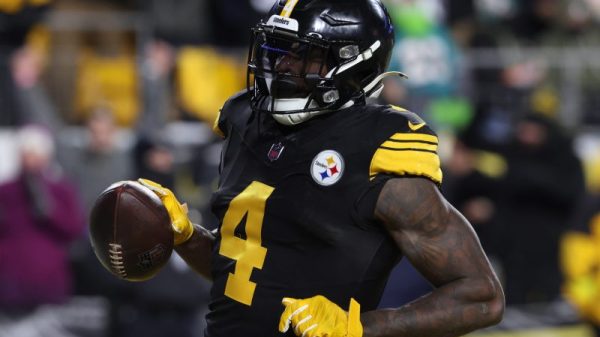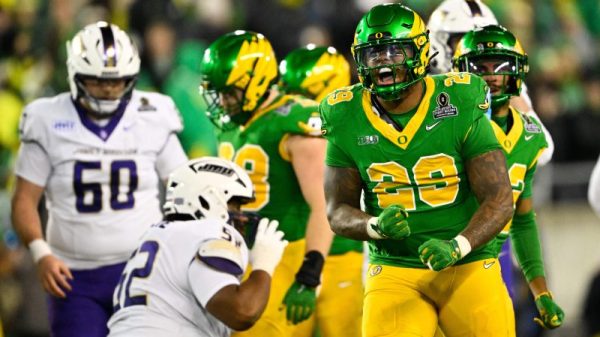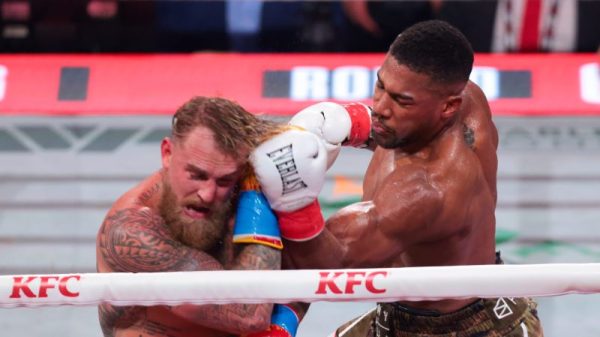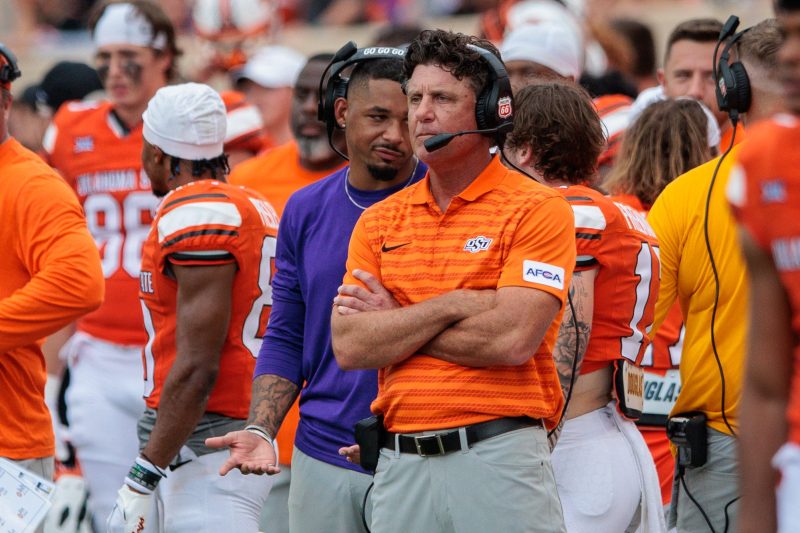Having more job security than almost any coach in college football has led Mike Gundy into a few unnecessary imbroglios over the years. But it has also freed him of the burden to talk the way most coaches think they are supposed to talk.
So when Gundy asked the Oklahoma State media on Monday whether they wanted the truth or coach-speak about how his staff ended up recruiting linebacker Obi Ezeigbo as a transfer from Division II Gannon University, there was only one answer. With Gundy, his version of the truth is always going to be worth the price of admission.
“He was very inexpensive,” Gundy said after Ezeigbo was named Big 12 newcomer of the week. “The number of players we go after that were ready to play at this level, we can’t afford. So he was a good buy and a really quality young man that had had success, and has physical characteristics we can work with and develop. So that’s why he ended up here, in my opinion. We saw some things we felt like we could develop into a good player at this level, and it wasn’t going to cost us the money we didn’t have.”
Like many things in college football these days, from Baylor coaches wearing t-shirts that say “We Pay Players” at a practice last month to Colorado quarterback Shedeur Sanders appearing on a Nike billboard in Times Square, the shock value is now pretty much gone. While Gundy’s comments got attention because we just don’t hear coaches draw such an explicit line between their name, image and likeness budgets and recruiting, what he said about Ezeigbo drew almost no negative reaction.
Because it was the truth.
And that’s one of the biggest signs of progress we’ve seen since NIL became a reality three years ago.
After decades of having to pretend that under-the-table money wasn’t a factor in recruiting, college sports have been liberated from the old fiction and placed into a new reality where player procurement is accepted as the commercial transaction it has always been.
It may not be romantic, but at least it’s real.
And it would benefit coaches, schools, players and fans to take a cue from Gundy and start talking about this stuff with more transparency.
Because even though we all now plainly understand that money is driving pretty much every decision in college sports, the actual machinations of how it works in recruiting are still pretty opaque — even to the people with the most skin in the game.
Coaches and administrators are experiencing this environment as people who, for the first time in their careers, are having to put a numerical value on a player while relying on hearsay and speculation to form a perception of what the marketplace really is.
The athletes are experiencing it a different way, with many of them relying on unskilled agents charging exorbitant commissions to inform them what their options are and what to expect.
And the fans are left relying on misinformation and rumor about an athlete’s value while being asked to fork over large sums of money to NIL collectives so that the player pipeline keeps flowing.
It can all be a little hard to understand. How much money do various schools have to spend? How is it getting allocated within a team? What do the bidding wars for recruits actually look like?
But with one almost off-hand comment by Gundy, we start to get a better sense of the college sports economy in action.
There’s no pretending that Oklahoma State has the ability to be a major player in the financial wars for top recruits or transfers. Gundy isn’t patting himself on the back about finding a diamond in the rough that nobody else in college football was smart enough to identify.
Instead, it was all very simple and straightforward: Gundy’s defense needed another capable body, Ezeigbo was on the transfer market looking for an opportunity to play at the highest level, and because he was coming from a Division II school there was no bidding frenzy that would price out a lower-budget school like Oklahoma State.
Why would that be offensive to anyone? Instead of spreading some flowery (and made-up) story about how much Ezeigbo loved the campus in Stillwater, laying out the reality of the situation here was plenty good enough for Gundy while also giving Oklahoma State fans a sense of how he and his staff are having to go about their jobs now in this complicated ecosystem.
While we can debate whether salary caps in professional sports have been good for the product or the athletes, what they’ve undeniably done is make fans more informed about roster-building and the difficult short- and long-term decisions that go into how players end up on certain teams.
When a player signs a contract, we know exactly how much salary cap space a player is going to take up, how many years their contract is guaranteed and the contingencies that will allow either side to change the terms of the deal. This information doesn’t just help people understand why a player chose one situation over another, or why a team signed one player over another, it allows people to see how the pieces all fit together and make better judgements about whether coaches and front offices are making the right decisions.
Over the long haul, that should be a goal for college sports as well. At some point, once we get past the various lawsuit settlements and NCAA rule changes and possible legislative solutions that will create a new pay-for-play model, schools are most likely going to have to work within some kind of framework where their resources are being allocated like a salary cap.
And, yes, that means certain athletes are going to have a higher monetary value than others, which is going to directly impact which schools they end up playing for. To acknowledge that publicly like Gundy did is a step in the right direction. It’s the way things have always worked to some degree, but it’s definitely the way it works now for everyone in college sports.
Three years into NIL, we can now handle the truth. Gundy deserves the highest praise for having the self-confidence to bring it into the discourse.



























